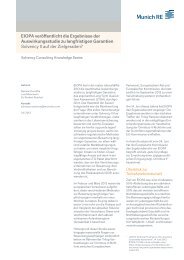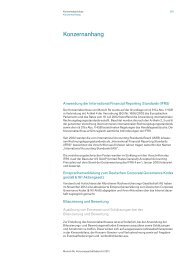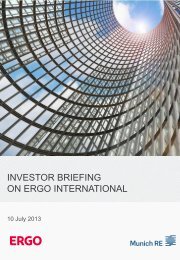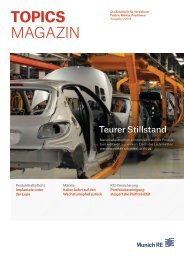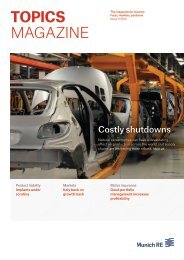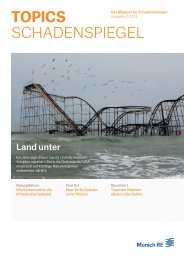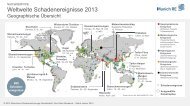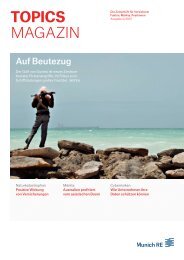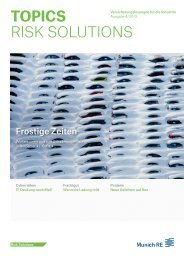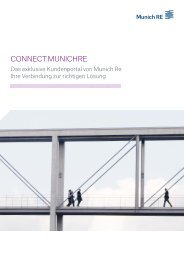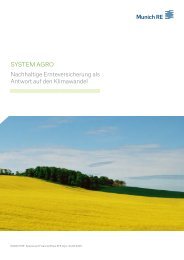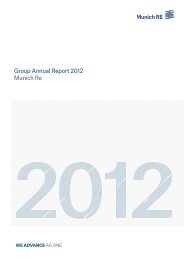Munich Re Group Annual Report 2006 (PDF, 1.8
Munich Re Group Annual Report 2006 (PDF, 1.8
Munich Re Group Annual Report 2006 (PDF, 1.8
Create successful ePaper yourself
Turn your PDF publications into a flip-book with our unique Google optimized e-Paper software.
<strong>Munich</strong> <strong>Re</strong> <strong>Group</strong> <strong>Annual</strong> <strong>Re</strong>port <strong>2006</strong><br />
Solvency II requirements (such as recognition of internal<br />
models, diversification benefits and the lead regulator concept)<br />
may make it easier in the future to recognise diversification<br />
benefits between primary insurance legal entities<br />
(and between reinsurance and primary insurance business<br />
segments) and reduce required capital accordingly.<br />
Value-based management<br />
Risk management tools and processes are embedded in<br />
our business steering concepts through the value-based<br />
management system applied in the <strong>Group</strong>. Various riskadjusted<br />
earnings targets are given to our business managers<br />
using the results of the <strong>Munich</strong> <strong>Re</strong> Capital Model or<br />
market-consistent embedded value framework. In this way,<br />
there is an explicit linkage of the results from the <strong>Munich</strong><br />
<strong>Re</strong> Capital Model to the remuneration of our business<br />
executives. The value-based management framework we<br />
deploy is geared to ensuring that business which is written<br />
by a business unit meets the technically risk-adequate<br />
price standard for the aggregate of the business unit’s portfolio.<br />
The technically risk-adequate price is defined as the<br />
price which reflects the sum of expected losses, acquisition<br />
and non-acquisition costs plus the cost of allocated<br />
risk capital, including an allowance for frictional costs.<br />
Risk measurement<br />
As a global risk carrier, we can diversify our portfolio through<br />
the broadest possible mix and spread of individual risks,<br />
thus significantly reducing the volatility of total claims payments<br />
and substantially increasing the value added by all<br />
divisional units.<br />
We are constantly refining the tools with which we<br />
monitor and manage risks. Our suite of tools for measuring<br />
risks is tailored to the business or operational segment we<br />
are monitoring. In each case, the lead risk measure is an<br />
economic risk measure designed to best reflect the risk in<br />
our portfolio. We also regularly compare these economic<br />
risk measures with both regulatory and rating-agency<br />
measures as part of our active capital management<br />
process. These comparisons are performed at many levels<br />
including <strong>Group</strong>, segment, legal entity, risk type, geographical<br />
and line of business. We also regularly perform<br />
126<br />
Management report_Risk report<br />
outside-in benchmarking of our capital model results and<br />
participate in industry surveys to constantly challenge and<br />
continuously refine our risk measurement tools so that<br />
they continue to reflect the most faithful representation of<br />
the economic risks in our portfolio. We have also adopted<br />
the <strong>Group</strong> of 30 recommendations for disclosure of economic<br />
capital to assist users of financial disclosures in<br />
making comparisons with our peers. In this context, we<br />
have published the results of our <strong>Munich</strong> <strong>Re</strong> Capital Model<br />
on our website and have also presented them to analysts<br />
for each year commencing 1 January since the calendar<br />
year 2001. The results of this for the year commencing<br />
1 January 2007 will be published in May 2007. To improve<br />
supervision of risks, we distinguish between market,<br />
credit, liquidity, insurance and operational risks.<br />
Qualitative risk assessment<br />
Whilst we are in a position to adequately assess the known<br />
risks in our portfolio, the growing complexity and dynamism<br />
of the environment in which we operate means that we<br />
must also remain vigilant with respect to the detection<br />
and representation of new or emerging risks. We follow a<br />
multidisciplinary approach in this regard using the knowhow<br />
and experience of geoscientists, biologists, specialist<br />
underwriters, lawyers, economists, sociologists and actuaries.<br />
For example, the Geo Risks <strong>Re</strong>search team for natural<br />
catastrophes consists of 28 staff, who have published<br />
numerous papers on the likely impact of climate change<br />
on the future frequency and severity of losses for the insurance<br />
industry. We utilise their research to ensure that<br />
the capitalisation for risks in our portfolio includes an<br />
allowance for the risk of change.<br />
For the holistic assessment of the risk situation, risk<br />
surveys coordinated by IRM (Integrated Risk Management)<br />
are conducted throughout the <strong>Munich</strong> <strong>Re</strong> <strong>Group</strong>.<br />
Such surveys consist partly of standardised reports<br />
based on risk questionnaires, meetings and workshops<br />
held with the individual departments and subsidiaries.<br />
These are supplemented by various top-down assessments<br />
from senior management on concrete topics. The<br />
findings thus obtained are additionally reconciled with our<br />
operative corporate planning process. Besides this, there



